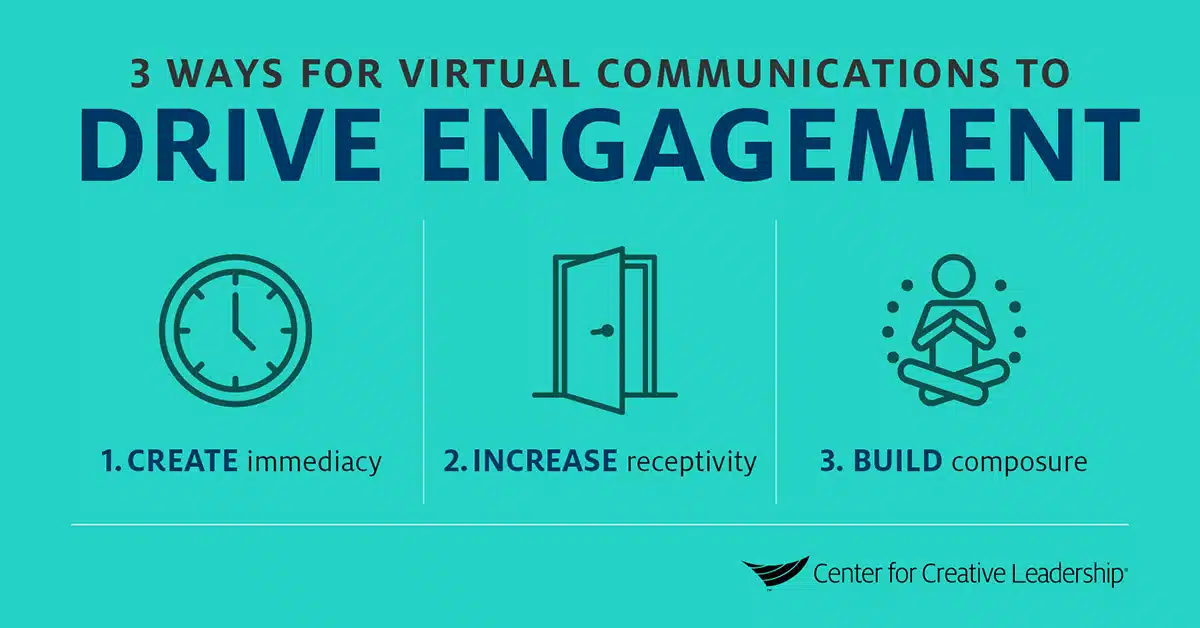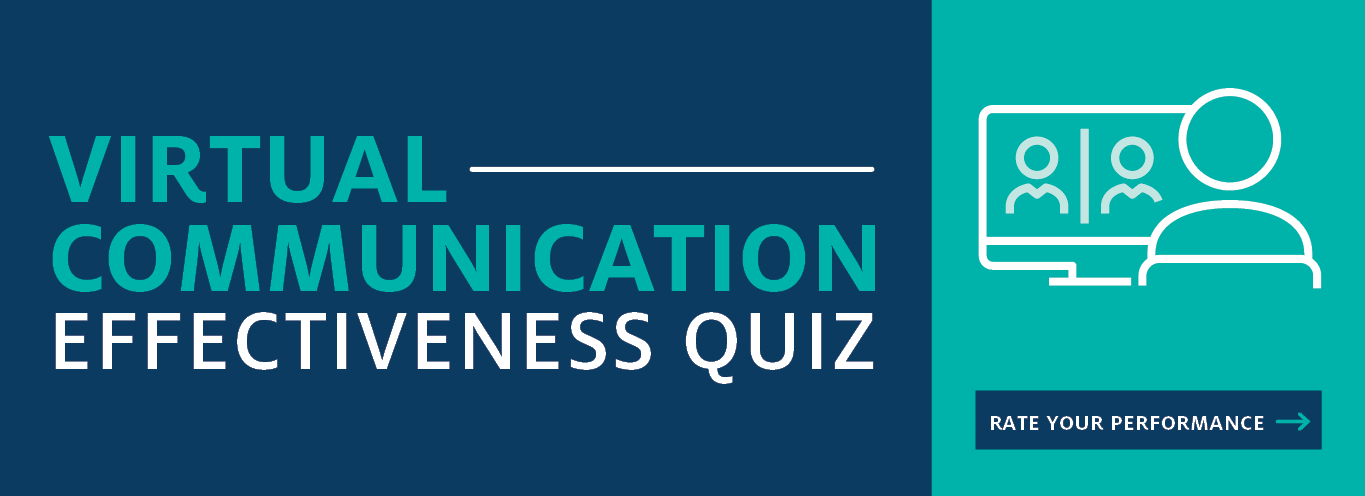For most of us, communicating with colleagues through a screen doesn’t come naturally, but we’ve adapted. After the COVID pandemic, we all know now to think about eye contact, mute buttons, unexpected interruptions, and frozen screens.
And though virtual collaboration isn’t the same as sitting together in person around a conference table, it has its benefits, and it isn’t going away anytime soon. In fact, it’s becoming increasingly clear that compelling and effective virtual communications will remain paramount going forward — for individual leaders, teams, and overall organizational success.
“Today’s leaders at all levels must be able communicate effectively, without a continuous physical presence,” notes Jerry Abrams, who serves on our Partnerships & Innovation team and who developed much of the content in our leading remote & virtual teams training.
Your audience’s perceptions of your virtual persona matter, he notes, because your virtual persona reflects your priorities and values, and shapes your personal leadership brand, which can help you build relationships, influence others, achieve goals, and sustain partnerships. These are all especially important when you’re geographically separated from your colleagues, leading a hybrid workforce or a fully remote team.
“The way your ideas land on others is shaped by the medium, and no one who strives to be a great virtual communicator can afford to ignore their virtual persona.”
“As a telecommuter myself for almost a decade, my biggest fear — and I suspect I’m not alone — is that I’m losing my audience, that I am not engaging them,” says Abrams. “And let’s face it; in the virtual world, if you lose your audience, you’re done.”
Strengthen Your Virtual Persona With Our Virtual Communications Tips
Just as leaders can work to improve their communication in general, there are a number of simple improvements you can start making today that will have a big impact on your virtual persona.
The result? More effective virtual communications leads to an increased feeling of connectedness between you and your audience.
3 Steps to Ensure Your Virtual Communications Drive Engagement
Our virtual communications tips can help you drive greater engagement with your audiences. Just focus on these 3 steps to improve your virtual persona, in this order:
- Create immediacy;
- Increase receptivity; and
- Build composure.
(Note: Many of the following virtual communication tips presume that you’re able to stand and move freely within a reasonable area in front of your computer, and that it has a functioning camera, microphone, and speaker.)
1. First, create immediacy with your virtual communications.
Immediacy refers to the presence, attraction, and warmth your audience perceives when you’re engaging in virtual communication. In other words, what is the impact you have on your audience? The following actions will improve your immediacy by demonstrating an intense involvement in the conversation:
- Convey enthusiasm about the topic you’re presenting. If you’re bored, your audience will pick up on that.
- Vary the pitch, volume, and pace of your speaking.
- Be “animated” when presenting to and interacting with the audience.
- Speak with your hands too, using gestures to reinforce your words.
- Be aware of and use facial expressions to reinforce your points.
- Increase your use of present tense verbs and inclusive pronouns like “we” and “our.”
- Look directly at the camera for several seconds at a time when speaking.
- Lean in toward the camera to reduce the sense of “distance” between you and the audience.
2. Increase receptivity to your virtual communications.
Receptivity refers to a mutual sense of interest, openness, and trust. Convey a willingness to really listen to your colleagues in the virtual space, as well as an openness to their ideas and suggestions, through the following actions:
- Smile when interacting with a member of the audience.
- Look directly into the camera when listening and responding to a member of the audience to create the impression that you are “facing” them.
- When appropriate, don’t be afraid to laugh along with others, as it signals receptivity.
- Use nods appropriately to acknowledge others’ feelings and thoughts.
- Be honest and authentic.
- Ensure you’re using active listening techniques and affirming the experiences, problems, and stories of others.
The benefits of a focus on receptivity? You’ll improve your team’s morale while also strengthening your own leadership image, which will ultimately lead to greater success at landing your message and achieving your goals.
3. Build composure for more effective virtual communications.
If you feel calm and relaxed when engaging in virtual communication, your audience will sense your composure. Alternatively, when you’re visibly paying attention to yourself, your appearance, or your own thoughts, your audience will sense your distraction and feel a lack of confidence in your authority. The following behaviors convey to your audience that you feel relaxed, confident, and composed:
- Be aware of your body language. Avoid holding your posture rigid, frequently shifting, or appearing tense.
- Refrain from “nervous” actions like playing with your hair or fidgeting.
- Maximize your speaking fluency by eliminating repetitions and pause-fillers like um, er, ah, etc.
- Speak at an audible, but not extremely loud, level so that your volume doesn’t detract from your message.
- Be appropriately “animated” by tailoring your nonverbal behaviors to reinforce your message and content.
It helps to think of building composure as simply increasing your “stage presence” through rehearsal. After all, there are several parallels between the performing arts and virtual communications — one of them being, the more you practice, the better you’ll get and the more comfortable you’ll feel.
“Several coaches put it this way — amateurs practice until they get it right. Professionals practice until they can’t get it wrong!” adds Abrams.
So if you really want to take your virtual communications to the next level, try recording yourself and then honestly evaluating your performance. Whatever you notice most, start working there to improve.
One additional virtual communication tip to help you build your composure: Before performers go on stage, they’ll often take a moment to close their eyes and visualize an experience that brought forward an emotion they want to project. This trick works in a virtual setting, as well.
“For example, when trying to convey warmth or enthusiasm, take a moment before you start your session to recall a topic, event, or time when you really had a strong feeling of warmth toward others — or felt a strong feeling of enthusiasm for something you were saying or doing,” says Abrams.
“As you visualize the experience, pay attention to all the various feelings and sensations you can recall, including sights, sounds, and smells. These memories help you ground your virtual persona in real experience and add authenticity to your virtual communications.”
That authenticity is key, by the way. We’ve found that creating authentic connections is one of the 3 keys to unlocking the benefits of online learning for leadership development. In our experience, that’s what helps facilitators “reach through the screen” and truly engage participants actively in our virtual leadership programs.
Access Our Webinar!
Watch our webinar, How to Practice Authentic Communication in a Virtual Space Through the Power of Listening, and learn specific actions to take — and avoid — in order to improve your listening skills and reduce conflict while communicating virtually.
Upskill Virtual Communication Skills for Yourself & Your Team
Start by Assessing Your Own Virtual Communication Effectiveness With Our Quiz
As a leader, you’re responsible not only for your own performance, but also for that of your people — many of whom may also face struggles with virtual communication effectiveness.
As you manage remote or hybrid teams, work to follow best practices for managing virtual teams and meetings and and consider how various online leadership development solutions could benefit your team’s work.
Once you’ve tried our virtual communications tips to strengthen your virtual persona, you may want to get some feedback on how you’re doing, and also take time to reflect yourself.
Use our free Virtual Communication Effectiveness Quiz to assess the effectiveness of your virtual persona’s performance, and continue to develop by following the virtual communication tips and recommended next steps provided.
You may also want to use our easy email template to send a version of this quiz to your colleagues to get their candid feedback on the effectiveness of your virtual communications, too.
Ready to Take the Next Step?
In today’s new world of work, effective virtual communication for leaders is essential. Partner with us to craft a customized learning journey for your team using our research-based modules. Available leadership topics include Authenticity, Communication & Leadership, Emotional Intelligence, Listening to Understand, Psychological Safety & Trust, Self-Awareness, Virtual & Remote Team Leadership, and more.










